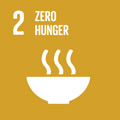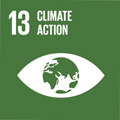- Docente: Francesco Orsini
- Credits: 6
- SSD: AGR/04
- Language: English
- Moduli: Francesco Orsini (Modulo 1) Giorgio Prosdocimi Gianquinto (Modulo 2)
- Teaching Mode: In-person learning (entirely or partially) (Modulo 1); In-person learning (entirely or partially) (Modulo 2)
- Campus: Bologna
- Corso: Second cycle degree programme (LM) in Sciences and Management of Nature (cod. 9257)
Learning outcomes
The aim of this course is to respond to the global demand for urban green innovation (environmental technologies, eco-friendly products and services, sustainable design and healthy food) by equipping actual and future entrepreneurs with the set of useful skills and competences needed to start business oriented initiatives in urban agriculture. The course has been defined and designed according to the results of the training needs assessment during the ERASMUS + project ""Urban Green Train"". It will be delivered as blended course: a part as eLearning (at distance learning delivered through Moodle) and the rest as face to face modality. The course is structured into 5 Modules: Module 1: Introduction into urban agriculture concept and types (main concepts and challenges related to urban agriculture and worldwide evolution); Module 2: Resource use from a challenge perspective (relationship between urban agriculture and urban ecology); Module 3: Urban agriculture types/production systems and short food chains (various urban agriculture types found in cities around the world); Module 4: Networking and governance (importance of policy schemes and regulations, communication with private and public stakeholders, and the building of social networks for successful urban agriculture initiatives); Module 5: World of business and urban demands (entrepreneurial and economic dimensions of urban agriculture).
Course contents
Prof. Giorgio Prosdocimi Gianquinto
Unit 1# - Introduction to Global Challenges for Natural Resources
- World Population, Food Security, Energy Need and Fossil Fuel Combustion, Global Warming, Arable Land Area, Water Scarcity, Soil Degradation and Desertification, Rural Poverty
Unit 2# - Agriculture and Climate change
- Ecosystem services in agriculture
- The contribution of agriculture to climate change (main sources GHGs emissions by region: deforestation, enteric fermentation from ruminants in livestock, manure left on fields, applied chemical fertilizers and rice cultivation practices)
- Agriculture and hydrological cycle
- The impacts of climate change on agriculture and food security
Unit 3# - Introduction to Sustainable Agriculture
- Agricultural Systems (the common and the emerging paradigms)
- Sustainable Agriculture in the past and the modern agriculture
- History of Sustainability and definition of Sustainable Agriculture
- Farming systems (family farming), Crop selection, soils, cultivation and tillage, plant nutrition, pest management, water use, energy use, biodiversity in Sustainable Agriculture
- Sustainability issues in developed vs. developing countries
- Agroecology in crop production (definition and main practices in Agroecology Farming)
- Organic Agriculture (legislation, practices, yield, product quality and emissions=
Unit 4# - History and Evolution of Urban Horticulture
- The garden in ancient civilizations (Egyptian, Greek and Roman gardens)
- The medieval hortus conclusus and the Arabic garden
- From Renaissance to Modern age
- Industrialization and urban horticulture (Schrebergärten, Jardins ouvriers, Migrant gardens, Orti Operai, Victory Gardens)
- Gardens from the 60’ till today (Social and community gardens)
Unit 5# - Problems related to increasing urbanization (urban sprawl)
- Reduction of arable and/or fertile land
- Fragmentation of ecosystems
- Food price
- Pollution
- Concreting and soil sealing
- “Heat Island” effect
- Socioeconomic constrains and higher povertyin suburbs
- Food insecurity
Unit 6# - Urban Horticulture and its multifunctional role in the city
- Urban Agriculture (horticulture) as strategy to alleviate poverty and improve food security in the cities
- Definition of Urban Agriculture (horticulture)
- Multifunctionality of Urban Horticulture: Food security (food production & food safety), Health (diet diversification and therapeutical horticulture), Social inclusion, Aesthetic and cultural, Education, Biodiversity (Design of ecological networks in the city), Climatic resilience, Income generation
- Sustainability of Urban Horticulture
Unit 7# - Soilless Culture- High & low tech cultivation systems to produce vegetables & flowers
- Definition and origin of soilless culture
- Classification and pros & cons of soilless culture
- Main soilless systems (NFT, floating hydroponics, aeroponics, bag and container systems, grodan)
- Future of hydroponics
- Simplified soilless systems (systems for developing countries and for our cities)
Prof. Francesco Orsini
Unit 1# - Course introduction.
- Course description
- Methodology for groupwork and assignments
- Online resources and textbooks
- Assessment methodology
Unit 2# - Business models in urban agriculture.
- Classification of business models
- Cost-reduction BM
- Differentiation BM
- Diversification BM
- Share Economy BM
- Experience BM
- Experimental BM
Unit 3# - Vegetable crops physiology.
- Basics of vegetable crops physiology
- Plant growth
- Plant development
- Plant response to environmental factors (light, CO2, temperature, humidity)
Unit 4#
- Urban agriculture in the framework of city planning.
- Vertical farming systems.
- Sustainability assessment in vertical farms.
- Building integrated agriculture
Unit 5# - Groupworks
- Elaborating a pitch to support a urban farming project.
- Design and planning of an innovative urban agriculture project.
- Literature review and analysis of case studies.
Unit 6# - Technical visits
- Aquaponics: Aquaponic design,
- Vertical Farming: Agricola Moderna
- Community gardening and technology innovation: Salus W Space,
- Social farming: Spazio Battirame
Readings/Bibliography
Suggested readings:
Orsini, F., Dubbeling, M., de Zeeuw, H., Gianquinto, G., Eds. (2017). Rooftop Urban Agriculture. Springer, The Netherlands. ISBN 978-3-319-57720-3.
Kozai, T., Niu, G., Takagaki, M. (2015). Plant Factory: an indoor vertical farming system for efficient quality food production Cambridge Academic Press.
Lohrberg, F., Lička, L., Scazzosi, L., & Timpe, A. (Eds.). (2016). Urban agriculture europe. Jovis.
Bell, S., Fox-Kämper, R., Keshavarz, N., Benson, M., Caputo, S., Noori, S., & Voigt, A. (Eds.). (2016). Urban allotment gardens in Europe. Routledge.
Kozai, T. (2016). LED lighting for urban agriculture. Springer, Singapore.
Teaching methods
E-learning, powerpoint presentations, online tests, forum, assignments;
Participation to the international student challenge UrbanFarm2021.Assessment methods
Multiple choice test. Additional points are also available for student taking part in groupwork or assignments whenever they achieve at least 18/30. To pass the exam, students need to complete the written part and discuss and substantiate the answers within an oral session.
The exam will take place in both Teams and Zoom platform. Students are requested to perform the exam on Zoom using a PC and have another device (e.g. tablet/mobile phone) connected to Teams. A valid ID and the student badge will be needed in order to confirm identity. The videos of the exam will be recorded and may be used againt frauds or irregolarities.
The test consists of 45 closed-ended questions chosen in the areas listed in the course program available in IOL. For each correct answer a score equal to 1 is assigned, for each wrong answer a score equal to -0.5 is attributed, while in the absence of an answer there is no penalty. The overall score is obtained by the algebraic sum of the individual scores and their normalization on a 30/30 basis. To pass the exam (and eventually access additional points collected throughout the course), students need to score at least 18 in the quiz and undertake a short oral discussion on the answers provided during the quiz. Cum Laude is awarded when an overall score equal to or greater than 32 points has been obtained.
The maximum duration for the written test is 60 minutes.
NB: The navigation method is sequential and the student must proceed neatly: it is not possible to go back or jump forward.
ATTENTION: when providing the answer (right or wrong) or when not answering and moving to the next question, it is not possible to go back and change the selection.
Teaching tools
Powerpoint presentations, exercise, theoretical and practical workshops and groupwork activities.
Links to further information
https://site.unibo.it/urban-farm/en
Office hours
See the website of Francesco Orsini
See the website of Giorgio Prosdocimi Gianquinto
SDGs



This teaching activity contributes to the achievement of the Sustainable Development Goals of the UN 2030 Agenda.
